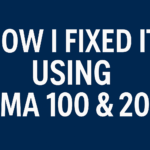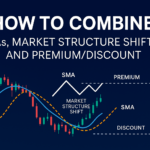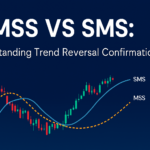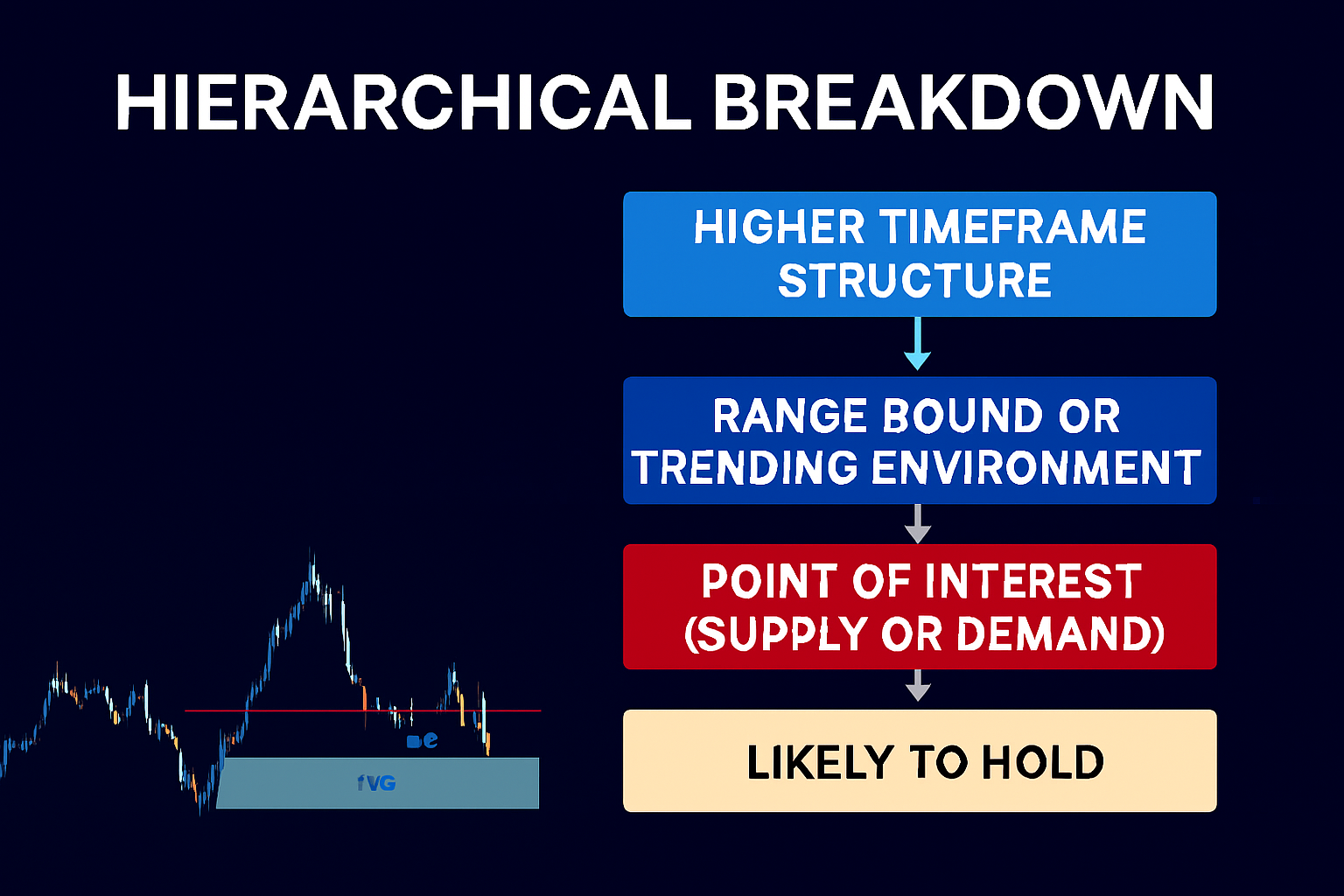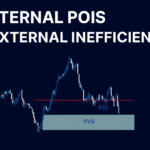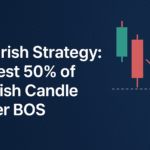A Complete Guide to Hybrid Smart Money & Orderflow Structure [Credits to DAX]
Introduction
The D-LuX Swing Trading Strategy is the culmination of six months of in-depth research, testing, and conceptual understanding of how prices move across multiple timeframes. It combines the Smart Money Concept (SMC) with Order Flow tools to detect swing-based trade setups using liquidity sweeps, breaks in structure, and volume-based confirmations.
This guide reflects a professional-level understanding developed through practical study and market observation, refined to help serious swing traders execute with precision.
1. Market Structure Mastery
Swing Structure Definitions
- Main Structure (Swing Highs/Lows): These are the significant pivot points on the higher timeframe (H4/H1) that break structure.
- Sub-Structure: The internal movements between the major swings, often used for refined entries.
🔍 Tip: Look for sub-structures forming HL or LH before the BOS – these are your confirmation layers.
Structural Flow in a Bullish Scenario
- Sweep of Liquidity (grabbing external liquidity below/above key swing points)
- CHOCH (Change of Character): Break of internal structure against the trend, hinting at a shift.
- BOS (Break of Structure): Major swing is broken in the new direction.
- HL Formation: Pullback must form a clear higher low, with the previous swing protected.
- Second BOS: Confirms direction.
- Final Liquidity Sweep of HL: This is a trap to shake out weak hands before takeoff.
Illustration
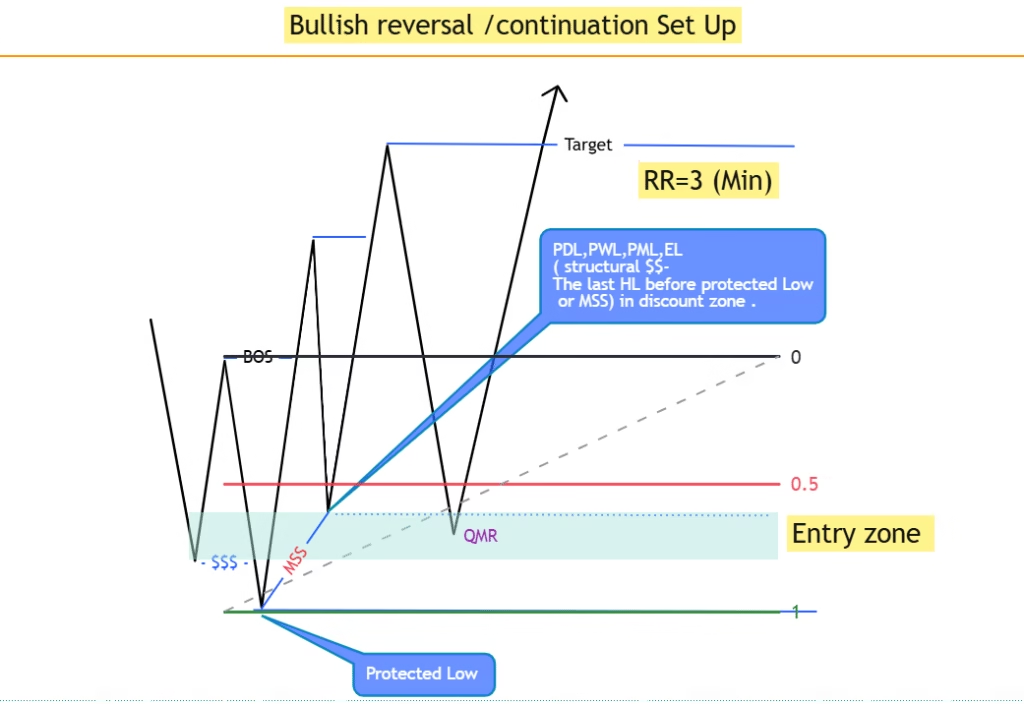
2. Premium & Discount Zones
Use the 50% Fibonacci retracement tool:
- If buying → wait for price to enter Discount Zone (below 50%).
- If selling → wait for price to enter Premium Zone (above 50%).
📌 Golden Rule: Never buy in premium or sell in discount, regardless of trend bias. Always wait for mitigation.
3. Orderflow Validation – Momentum Behind Price
Once structural conditions are met, orderflow tools help you validate the setup.
a) Cumulative Delta (CVD) Divergence
- Bullish Signal: Price makes a lower low, but delta makes a higher low → buyers absorbing sell pressure.
- Bearish Signal: Price makes a higher high, but delta makes a lower high → sellers absorbing buy pressure.
b) DOM (Depth of Market)
- Absorption: Aggressive market orders hit passive limit orders without price moving → large player absorption.
- Spoofing: Large orders appear but vanish = trap.
- Stacking: Clustering of orders at key prices = true intent.
🎯 These tools reveal the true intention behind candles.
4. Entry Checklist ✅❌
Structure Confluence:
- ✅ Price in correct zone (discount for buys, premium for sells)
- ✅ Liquidity sweep occurred
- ✅ CHOCH and BOS printed
- ✅ HL or LH formed and respected
- ✅ Second BOS confirms strength
- ✅ Final liquidity sweep before entry
Orderflow Confluence:
- ✅ Absorption detected at HL/LH
- ✅ CVD divergence aligns with intent
- ✅ DOM shows aggressive intent
- ✅ Session timing (London/NY) matches
5. Invalidation Rules ❌
Structure:
- ❌ Main swing low/high is broken (invalidates idea)
- ❌ No follow-up BOS after CHOCH
- ❌ HL/LH is too deep or inconsistent
- ❌ Entry taken in wrong zone
Orderflow:
- ❌ No absorption detected
- ❌ No trapped traders seen
- ❌ DOM shows spoofing or no commitment
6. DOM and Orderflow Nuance
Even though orderflow is often used for scalping, it complements swing trading by:
- Confirming when big players are entering
- Showing exhaustion of one side (via delta or DOM)
- Highlighting false breakouts via spoofing
How to use DOM here:
- Watch for aggressive market buys into stacked sell orders that don’t move price = seller absorption → bullish
- If large spoofed orders disappear = no conviction = avoid entry
7. Summary Thought Process (D-LuX Logic)
✅ Structure first (macro to micro)
✅ Wait for price to come to your level (discount/premium)
✅ Use CHOCH + BOS to confirm shift
✅ Add orderflow layer (DOM/CVD) to validate intent
✅ Avoid emotional entries – only execute complete checklist
✨ The result is a highly disciplined, data-driven swing trade setup with sniper-like accuracy.
8. Market Condition Checklist (Tailored for D-LuX)
🔹 Step 1: Identify Market Environment
| Condition | Trending | Ranging |
|---|---|---|
| Clear BOS and HL/LH forming | ✅ Yes | ❌ No |
| Price respecting swing structure | ✅ Yes | ❌ No |
| Wide impulsive moves, narrow pullbacks | ✅ Yes | ❌ No |
| Equal highs/lows forming repeatedly | ❌ No | ✅ Yes |
| Price bouncing between fixed zones | ❌ No | ✅ Yes |
| No clear CHOCH → BOS sequence | ❌ No | ✅ Yes (fakeouts) |
🔹 Step 2: Tools & Visual Confirmation
| Indicator or Tool | Trending Bias | Ranging Bias |
| 50 EMA / Trendline | Price riding above/below with clean structure | Crossing up/down frequently |
| CVD (Delta) | Shows real divergence at swing HL/LH | No consistent divergence |
| DOM | Strong stacking & holding near structural zones | Random spoofing, no clear buyer/seller intent |
🔹 Step 3: Decision Filter for Entry
If Market is Trending:
✅ Proceed with full D-LuX sequence:
- Sweep of liquidity → CHOCH → BOS → HL/LH → BOS → Entry
- Use FVG + Orderflow confluence at HL/LH
If Market is Ranging:
⚠️ Only trade near range boundaries:
- Sweep of range high/low → CHOCH → BOS into middle of range
- Confirm with strong absorption and trap detection
- Avoid mid-range entries — wait for extremes!
🚫 Avoid Trading When:
- No BOS/CHOCH for several sessions
- Price is in mid-zone between premium and discount with no clear intent
- CVD and DOM show no aggression
- Price is compressing (triangle/flag) inside the range with no expansion
🧠 Quick Mental Cue:
“If the market builds and respects swing structure, I execute the full D-LuX strategy.
If it rotates between extremes, I only trade the edges — and with extra confirmation.”
9. Closing Thoughts
You’ve just walked through a hybrid pro-level strategy combining smart money structure and advanced volume profiling. With real market data, this becomes a powerful edge for swing trading across Forex majors, minors, and exotics.
More …
By D-LuX – Trading with Structure, Logic, and Precision.




